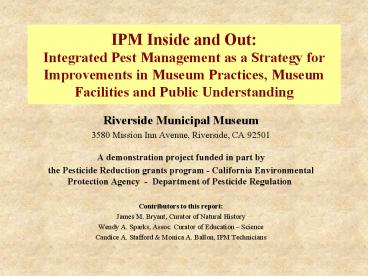IPM Inside and Out: Integrated Pest Management as a Strategy for Improvements in Museum Practices, M PowerPoint PPT Presentation
1 / 18
Title: IPM Inside and Out: Integrated Pest Management as a Strategy for Improvements in Museum Practices, M
1
IPM Inside and Out Integrated Pest Management
as a Strategy for Improvements in Museum
Practices, Museum Facilities and Public
Understanding
- Riverside Municipal Museum
- 3580 Mission Inn Avenue, Riverside, CA 92501
- A demonstration project funded in part by
- the Pesticide Reduction grants program -
California Environmental Protection Agency -
Department of Pesticide Regulation - Contributors to this report
- James M. Bryant, Curator of Natural History
- Wendy A. Sparks, Assoc. Curator of Education
Science - Candice A. Stafford Monica A. Ballon, IPM
Technicians
2
Integrated Pest Management (IPM) an
ecosystems approach to pest control that seeks
to protect museum staff and visiting public from
exposure to toxic chemicals. IPM is preventative
conservation, i.e. it tries to prevent the
conditions in which pests thrive from occurring
in museum settings.
The hard work part No one person on a museum
staff can be responsible for carrying out all IPM
methods. Everyone has a role to play.
European House Cricket Acheta domestica
3
- IPM Program Components
- Monitoring - checking pest traffic in areas of
active or potential infestation - Inspection - regular schedules of museum pest
assessment - Documentation - records of pest activity
- Thresholds - determination of acceptable
levels of pest infestation - Isolation - assessment of incoming materials for
pest contamination - Habitat modification - depriving pests of their
optimal environment - Good housekeeping - producing an environment
inhospitable to pests - Treatment action - pest removal procedures
specific to site and/or artifact - Evaluation - pest management program assessment
- Education - informing staff and the public of
methods and benefits of IPM
4
Riverside Municipal Museum3580 Mission Inn
Avenue Riverside, CA 92501
5
The Big Picture
Riverside gt
Inland Southern California Generally warm
temperatures (seldom freezes) Seasonal changes
in relative humidity Arid (averaging less than
10 in. of precipitation per year)
6
Integrated Pest Management Policy Brought an end
to all systematic use of biocides in building
interiors and workspaces Retained option to use
exterior pesticide applications (by a licensed
pest control contractor) to control invasive pest
species Preliminary monitoring Facility audit a
baseline of information on pest activity,
structural and environmental conditions
7
American Cockroach Periplaneta americana
Grant Funding Pesticide Reduction Demonstration
Project Grant Department of Pesticide
Regulation California Environmental Protection
Agency Project Title Multi disciplinary pest
management in a public museum setting Proposal
included a plan to modify the exterior
environment of the Municipal Museums downtown
museum building, through implementation of a new
landscape design.
8
Firebrat
Project Goals
- On the Outside
- Installation of new exterior landscape design, to
minimize incursions by urban pest species - Minor structural repairs and simplified/improved
building and - landscape maintenance
- Reductions in pollution of surface water runoff
(ultimately, - elimination of pesticide use around the building
exterior) - Provide other City departments (and other
museums) with a model program - Improved public awareness of IPM
- On the Inside
- Expanded/upgraded IPM activities, including pest
monitoring and data gathering - Demonstrated effectiveness of cessation of
pesticide use
9
Monitoring, Inspection Treatment
Project management pest monitoring/management
program (carried out by RMM staff) Regular
inspections exterior pesticide
applications (performed by a licensed pest
control contractor)
For exterior applications .
10
Housekeeping
Additional types of maintenance equipment New,
scheduled recorded exterior maintenance
activities General exterior cleanup sessions
11
Habitat modification
Landscape project design development and
approval (by a collaboration of RMM staff and
representatives from other City of Riverside
departments, plus faculty and students from the
landscape design program at California
Polytechnic University-Pomona).
12
Habitat modification
Landscape design and implementation (services
provided by licensed landscape architect and
contractors)
13
Documentation Evaluation
Capture and analysis of monitoring data
14
- Education
- informing staff and the public of the methods
- and benefits of IPM
- Public programs that appeal to many age groups
and learning styles
After-school family programs
The Museums Nature Lab
Temporary exhibits
Special events
15
Project Results
A growing IPM database Over 1400 database
records of trapped and observed invertebrate
species Roughly 6000 individuals caught or
observed in the buildings interior A
developing portrait of building ecology
The Urban Setting species from outside entering
via structural gaps, live mostly on organic
matter, but may damage on collections
Collections and Stored/Preserved Materials
Settings - the species threatening materials,
most frequently targeted by IPM efforts Warm,
Moist and Enclosed Settings - species that thrive
in such conditions, conditions which also
encourage mold, mildew, and fungus
16
Project results
17
Project Results
Habitat modification Removal of all plantings
in direct contact with the museum
building Harborage and water-use
reductions Creation of a dead zone
planting-free area 3 ft wide surrounding the
foundation perimeter Completion of the initial
phase of the landscape plan
Discovery of a significant source of structural
deterioration internal rainwater gutter and
downspout system
18
Project results
Over 6000 people have attended the Museums
IPM-centered programs Evaluations indicate
visitors enjoy live insects interacting with
scientists and learning the "fun facts" about
insects. Children enjoy learning
environmentally-friendly ways to repel insects
and other pests. On average, these programs 18
greater attendance than Museum programs that did
not.

